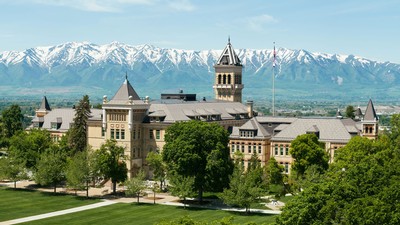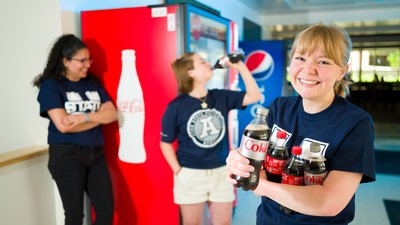USU's Spider Silk Research Spawns a Web of Literary Offerings
In his pursuits as a synthetic spider silk researcher, Utah State University USTAR professor Randy Lewis wears a lot of hats. In just one recent day, the molecular biologist was up at dawn at USU’s South Farm “with my arm up the backside of a goat,” assisting one of his transgenic nannies as she birthed a kid.
An hour or so later, Lewis was back on campus teaching a class, then dashing off to meet with state legislators haggling over funding for the coming year. That same afternoon, the scientist transported his “spider goats” to an exhibit at USU’s College of Engineering for a public celebration of National Engineering Week.
“I guess you could say I covered the gamut of my duties,” says Lewis, who joined USU’s Synthetic Bioproducts Center and Department of Biology in 2011.
The scientist’s research, which involves transfer of silk-producing genes from spiders to goats, silkworms, E. coli bacteria and alfalfa in an effort to efficiently manufacture large quantities of synthetic fiber for varied applications, has captured the interest of the media — adding “communicator” to the list of Lewis’ responsibilities. The professor regularly fields interviews with the likes of CNN, the Associated Press, the Discovery Channel and the BBC. A crew from Disney Channel recently visited his lab to capture footage for a Marvel Comics television episode.
Hot off the press are three new books, diverse in intended audience and scope, featuring the innovative research, which often seems the more science fiction than hard science.
In Bulletproof Skin: Exploring Boundaries by Piercing Barriers by Dutch bioartist Jalila Essaïdi, Lewis contributes the chapter “Spider Silk: The Bioengineering Approach.”
“Essaïdi’s book is kind of a ‘coffee table book’ that combines art, science and philosophy,” he says.
Lewis and Essaïdi collaborated on a project in which Essaidi used the genetically engineered spider silk in a lattice of human cells in an attempt to create bulletproof skin. The project was featured in a CNN report in August 2011.
For younger readers, Lewis’ research is the subject of author Bridget Heos’ Stronger than Steel, the most recent installment of Houghton Mifflin’s “Scientists in the Field” series. Aimed at children age 10 and older, the book has already passed a crucial test: Lewis’ grandchildren love it.
“The book follows my team and I from the University of Wyoming (where Lewis previously worked) to our new lab at USU,” Lewis says. “It features colorful pictures in a fun, inviting format.”
Rounding out the spate of literary offerings featuring USU’s spider silk research is former vice president Al Gore’s newly published The Future: Six Drivers of Global Change. Among the drivers Gore identifies is the emergence of biotechnologies that allow scientists to “seize active control over evolution.”
Though he doesn’t cite Lewis or USU by name, Gore presents Lewis’ spider silk research as an example of innovations in synthetic biology capable of generating radical change. Though offering the promise of exciting life improvements, the change, Gore says, leaves some people with a vague uneasiness he describes as “creepy.”
No, Gore isn’t making a clever pun about arachnids. Rather, he’s referring to “a comparably indeterminate ‘pre-fear’ that many feel when contemplating some of the onrushing advances in the world of genetic engineering.”
Creepy? Most people describe USU’s spider goats as “adorable.” In fact, Lewis makes an effort to display his goats in public as much as possible to demonstrate their “normalcy.” No one can tell the transgenic goats from those that haven’t received spider genes.
Even so, it’s no wonder Lewis’ goats and the corresponding research are capturing people’s imaginations. Applications Lewis envisions for the manufactured spider silks include synthetic ligaments, tendons, bone and skin, as well as air bags safe enough for young children and lighter, stronger, more comfortable body armor. A member of Lewis’ research team is investigating the glue spiders secrete to cement strands of web together as the basis for a surgical glue that, someday, could be used to heal human faces marred by trauma or disease and prevent debilitating disfigurement.
Related links:
Contact: Randy Lewis, 435-797-9291, randy.lewis@usu.edu
Writer: Mary-Ann Muffoletto, 435-797-3517, maryann.muffoletto@usu.edu
In his USTAR lab on USU's Innovation Campus, Randy Lewis displays two recently published books — one for art aficionados, one for children — featuring his innovative synthetic spider silk research.
In his newly published book 'The Future: Six Drivers of Global Change,' Al Gore cites Randy Lewis’ research as an example of emerging genetic engineering.
TOPICS
Genetics 63stories Spider Silk 19storiesComments and questions regarding this article may be directed to the contact person listed on this page.







